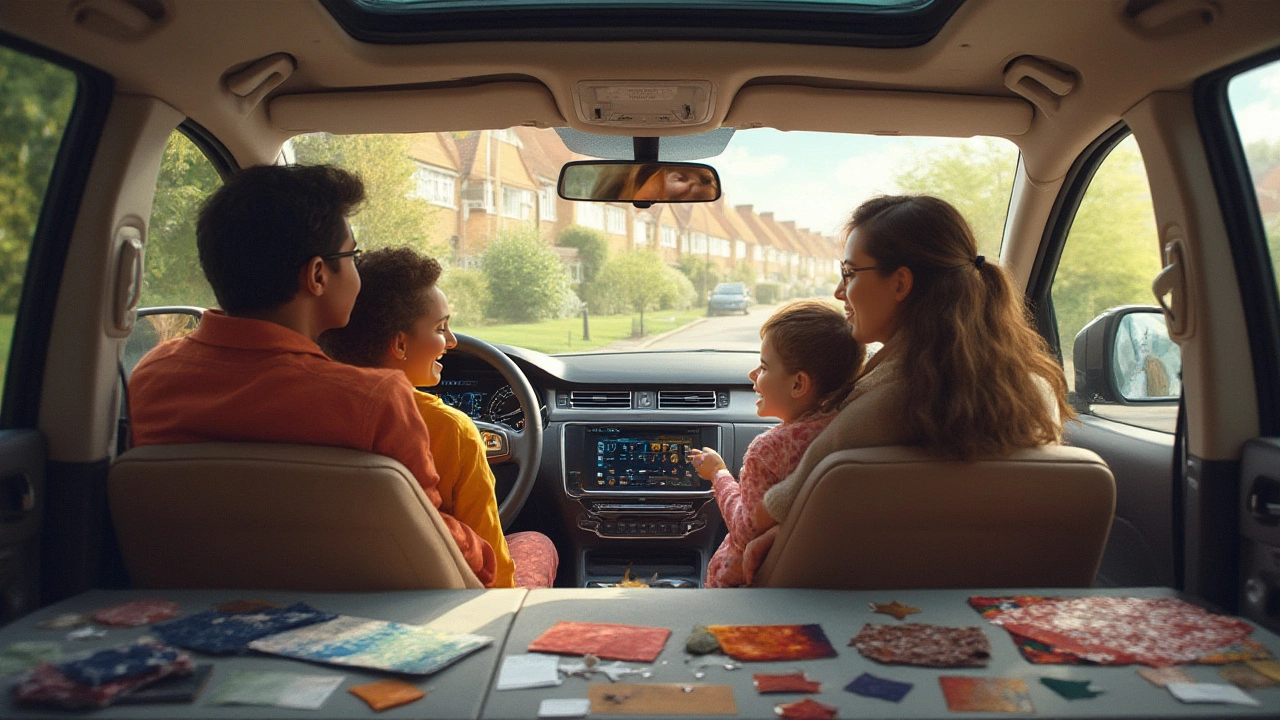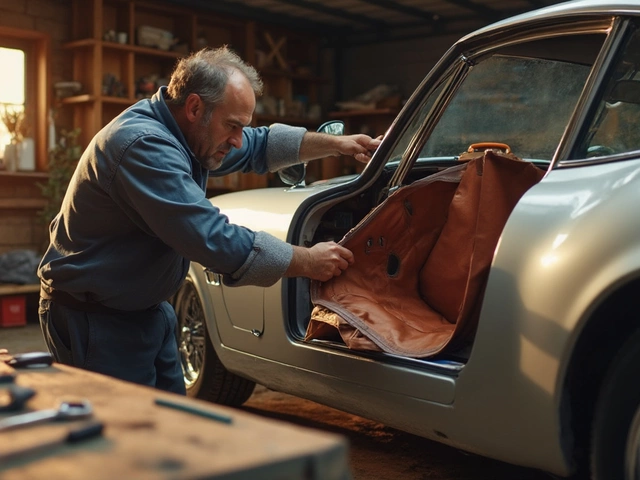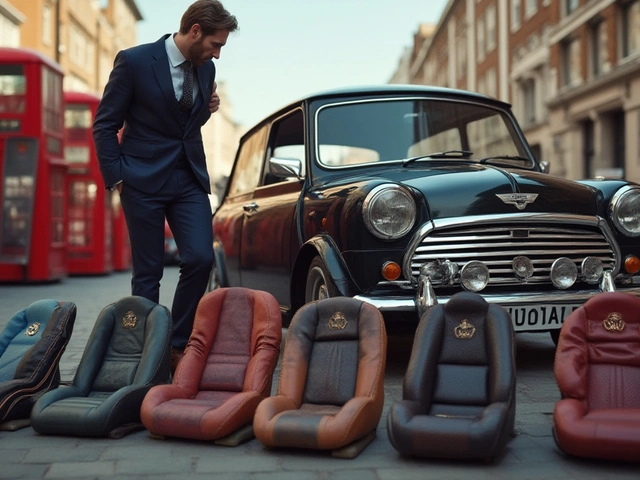Ever slid into a car and thought, "Man, this seat just doesn’t feel right"? Maybe you wanted a pop of color, a memory foam seat like your favorite office chair, or the kind of custom embroidery that turns heads when you open the door. Car enthusiasts know—seats do more than just keep you off the metal floor. They set the vibe for every drive. Troy, my son, asks why 'grown-ups care so much about car seats.' Well, once you’ve sat in a heated, perfectly bolstered leather seat on a winter morning, you get it. There’s a world of difference between factory options and the limitless world of custom car seats.
The Basics: What Goes Into Making Custom Car Seats?
Custom car seats aren’t just about choosing quirky colors or dropping your name in gold thread. Let’s break down what people actually mean by ‘custom’—because there’s a big gap between swapping a seat cover and reengineering the whole thing.
First, think about the base. The custom car seats journey usually starts with the existing seat structure. Unless you’re tinkering with race cars or vintage builds, most people keep the factory frame and focus on what’s wrapped around it. This means playing with foam density, the shape of the bolsters, and the angle for that perfect chill or sporty feel.
It’s all about the upholstery—leather, Alcantara, vinyl, or fabric blends you won’t find at the dealership. Customizations can get wild: perforated panels for breathability, contrast stitching, piping, custom embroidery, dual-tone layouts—the list goes on. Some brave souls, usually in the DIY crowd, even add power recliners, heated and cooled seats, lumbar massagers, and more.
But there are critical points to remember. Safety first—messing with seats can impact side airbags or seat sensors that trigger the airbags or notify you on the dash. You don't want a sweet ride that suddenly becomes unsafe on the road or gets you in trouble during inspections. Keep in mind that redoing the seat foam or adding hardware does sometimes void warranties or go against regulations in places like California or Germany.
This table lays out typical options and considerations you’ll see when building a custom seat:
| Feature | Options | Impact |
|---|---|---|
| Upholstery Material | Leather, Alcantara, vinyl, cloth | Comfort, durability, look |
| Foam Density | Soft, medium, firm | Support, fatigue, ergonomics |
| Bolstering | Low, moderate, aggressive | Cornering support, comfort |
| Heating/Cooling | Heated elements, ventilated fans | All-season comfort |
| Power Functions | Lumbar adjust, recline, memory | Ease of use, luxury |
| Stitching | Contrast, color matched, custom | Style, durability |
The best thing? There’s room for any taste or need. Whether you want all-black for a subtle look or neon threads with your gamer tag stitched into the headrest, it’s possible.
Options: Professional Shops, DIY Kits, and Everything In-Between
Let’s get real—if you want that true one-of-a-kind seat, you’ve got three main roads. Each comes with different cost, skill, and end-result vibes.
First up: professional upholstery shops. These places know every trick for matching or blowing past factory quality. Shops can tear down your seats, add new foam, sew custom covers, and even make entirely new seat “skins” from scratch. Expect prices from $1,500 to $6,000 or more for a full interior. Yeah, it’s not cheap, but the fit and finish? Hard to beat. The best part? They sort out tricky details like seat airbags, fitting the covers around controls, and getting the seams razor-sharp. Good shops will match your ideas to practical reality, suggesting stuff you might not have thought about, like UV-resistant leather or stain-guard coatings if you’ve got kids like Troy climbing all over the backseat with chocolate fingers.
Then there are seat cover specialists. Companies like Katzkin, Alea Leather, or Roadwire make model-specific kits—think jigsaw puzzles for your car seats. You can DIY, especially if you’ve got a heat gun, pliers, and patience. Most pro shops will install them for a fee, ensuring that tight, wrinkle-free look. The cost? Usually $600–$2,500 installed, depending on the material and extras like embroidery or two-tone designs. While they can’t change the basic shape or foam, these kits totally transform the vibe inside.
If you’re handy and itching for a weekend project, there’s full-on DIY. It’s more common with classic cars or vans, where owners strip seats to the bare frame and rebuild using foam blocks, hog rings, and custom-sewn covers. You can try it with modern cars, but good luck with airbags and electronics unless you’re up for a challenge. Plenty of YouTube tutorials walk through each step, and you can buy tools like hog ring pliers, foam contour cutters, or even portable sewing machines. Materials cost less than pro installs, but be ready to sacrifice some weekends and maybe lose a little sanity. Also, keep extra material for the classic "oops, don’t fit!" moments.
Here’s a pro tip: always consider resale. While you might love red tartan plaid or hot-pink suede, future buyers might not. Stick with neutral colors for mass appeal, or keep your factory seat covers in storage so you can swap back if needed down the line. That’s one trick some car flippers use to boost value in the used market.

Tech, Safety, and Legal Stuff to Watch Out For
We can’t talk custom seats without going into the modern bits—because today’s car seats aren’t just cushions any more. Since the mid-2000s, most seats come with built-in airbags, wiring for seat sensors, heating pads, and sometimes complex power rails. Messing with the wrong parts can break warning light circuits, or even stop airbags from firing correctly in a crash. That’s every parent’s nightmare—Troy loves roughhousing on road trips, and I need every piece of safety tech working for us, not against us.
For cars made after 2012, seats often include occupancy sensors to warn if someone’s sitting without a seatbelt, or to control airbags. Upgrading just the upholstery might sound simple, but sometimes the electronics are literally sewn into the original covers. A good shop will know which cars are easier to modify and which pose risks. Porsche 911s, for example, integrate seat airbags right under the leather, while some Toyotas have foam-molded airbag channels. Replacing covers on your own can trip up airbag systems, so always double-check manufacturer guides or ask a certified pro.
On the legal side, many regions require modifications to meet national safety standards. The US, UK, and most of Europe have rules about tampering with airbags or seat structures. In Germany, for instance, you can’t just add racing-style seats to a street car unless they’re approved and registered. Miss a step, and you could fail inspection or lose insurance coverage after a crash. Some insurers flat-out void policies on cars with homebuilt modifications. The key? If you’re ever unsure, ask about TUV, DOT, or equivalent approvals before buying custom seats or kits. An hour spent reading up can save thousands in repairs or legal headaches down the line.
One more overlooked detail—heated or cooled seats draw power. Upgrading from regular foam seats to full luxury-spec with all the gadgets may need wiring upgrades or bigger fuses. Bad wiring jobs can fry circuits or even start fires. If you’ve got a hybrid or EV, extra electronics sometimes play havoc with range calculations. Always check the limits, especially if your car is loaded with features from the factory.
Making It Yours: Inspiration and Unique Ideas for Custom Car Seats
This is the fun part—the sky’s the limit when it comes to making your car’s interior the reflection of you (or the needs of your family). For some, custom car seats mean a luxury statement. Think: classic diamond-quilted nappa leather with contrasting blue thread. For others, it’s about a performance feel—Alcantara bolsters, carbon-fiber backings, racing harness slots. Parents like me? We’re begging for washable, waterproof materials, anti-microbial coatings, and maybe secret candy stashes stitched into seatbacks. And yes, you can ask an upholsterer for almost anything.
Travel a lot? Opt for memory foam padding tailored to your back shape, or massage modules built into the lower back area. Spend weekends at the track? Go with aggressive side bolsters, 6-point harness compatibility, and high-grip microsuede. Want your dog to ride in style? Custom pet-proof covers with reinforced stitching and easy-wash panels can be done. I’ve even seen seats done in tartan to match a favorite flannel shirt—and if you want your kid’s football jersey immortalized on the headrest, that’s possible too.
And don’t forget about sustainability. More companies now offer vegan leather, recycled PET fabric, and even upholstery made from reclaimed fishing nets. It’s not just about looking good; it’s about feeling good about your environmental footprint, too. Some luxury brands like BMW and Tesla have even started mass-offering plant-based options on request, and independent shops follow suit for custom orders.
If you want a unique look, consider these finishing touches:
- Laser-cut perforated headrests, for breathability and a modern vibe.
- Integrated LEDs in the seat piping for a chill ambient glow at night (super cool for show cars).
- Custom embroidery, from subtle company logos to your name, favorite sports team, or even pop-culture quotes.
- Piping in bright contrast colors to match your car’s exterior paint or brake calipers.
Remember, the best upgrades serve your lifestyle. Hardcore off-roaders might want waterproof vinyl and extra-thick foam padding for comfort on rugged trails. Daily commuters may love heated and ventilated seats for unpredictable weather. And if your back aches after a long drive, ergonomic lumbar support is absolutely worth every penny.
Got friends with similar interests? Crowdsource ideas or group-buy from a trusted shop—sometimes, collective orders get serious discounts. There are even community forums online (like forums for classic BMWs, Mustangs, or Honda Civics) where people share before-and-after shots, vendor recommendations, and helpful how-to videos. Swapping stories beats reading sterile reviews any day. I once found the best seat foam tip from a Mustang forum—who knew replacing the lower cushion would stop my leg from going numb on road trips?
So, can you make custom car seats? Absolutely. The real question—just how far do you want to go? Add comfort, inject style, or chase the ultimate fit. With the right plan, a bit of inspiration, and the right help, you can turn your daily drive into your personal comfort zone—one custom seat at a time.




